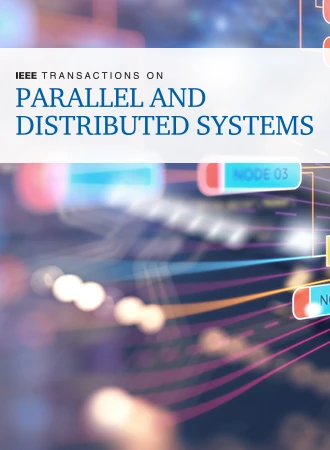Beyond Belady to Attain a Seemingly Unattainable Byte Miss Ratio for Content Delivery Networks
IF 5.6
2区 计算机科学
Q1 COMPUTER SCIENCE, THEORY & METHODS
IEEE Transactions on Parallel and Distributed Systems
Pub Date : 2024-08-30
DOI:10.1109/TPDS.2024.3452096
引用次数: 0
Abstract
Reducing the byte miss ratio (BMR) in the Content Delivery Network (CDN) caches can help providers save on the cost of paying for traffic. When evicting objects or files of different sizes in the caches of CDNs, it is no longer sufficient to pursue an optimal object miss ratio (OMR) by approximating Belady to ensure an optimal BMR. Our experimental observations suggest that there are multiple request sequence windows. In these windows, a replacement policy prioritizes the eviction of objects with large sizes and ultimately evicts the object with the longest reuse distance, lowering the BMR without increasing the OMR. To accurately capture those windows, we monitor the changes in OMR and BMR using a deep reinforcement learning (RL) model and then implement a BMR-friendly replacement algorithm in these windows. Based on this policy, we propose a Belady and Size Eviction (LRU-BaSE) algorithm that reduces BMR while maintaining OMR. To make LRU-BaSE efficient and practical, we address the feedback delay problem of RL with a two-pronged approach. On the one hand, we shorten the LRU-base decision region based on the observation that the rear section of the cache queue contains most of the eviction candidates. On the other hand, the request distribution on CDNs makes it feasible to divide the learning region into multiple sub-regions that are each learned with reduced time and increased accuracy. In real CDN systems, LRU-BaSE outperforms LRU by reducing “backing to OS” traffic and access latency by 30.05% and 17.07%, respectively, on average. In simulator tests, LRU-BaSE outperforms state-of-the-art cache replacement policies. On average, LRU-BaSE's BMR is 0.63% and 0.33% less than that of Belady and Practical Flow-based Offline Optimal (PFOO), respectively. In addition, compared to Learning Relaxed Belady (LRB), LRU-BaSE can yield relatively stable performance when facing workload drift.超越 Belady,为内容交付网络实现看似遥不可及的字节遗漏率
降低内容分发网络(CDN)缓存中的字节遗漏率(BMR)可以帮助提供商节省流量付费成本。在驱逐 CDN 缓存中不同大小的对象或文件时,通过近似贝拉迪(Belady)来追求最佳对象遗漏率(OMR)以确保最佳字节遗漏率(BMR)已经不够了。我们的实验观察表明,存在多个请求序列窗口。在这些窗口中,替换策略会优先驱逐尺寸较大的对象,并最终驱逐重用距离最长的对象,从而在不增加 OMR 的情况下降低 BMR。为了准确捕捉这些窗口,我们使用深度强化学习(RL)模型监控 OMR 和 BMR 的变化,然后在这些窗口中实施 BMR 友好替换算法。基于这一策略,我们提出了一种 "Belady and Size Eviction"(LRU-BaSE)算法,可在保持 OMR 的同时降低 BMR。为了使 LRU-BaSE 高效实用,我们采用双管齐下的方法来解决 RL 的反馈延迟问题。一方面,我们根据高速缓存队列后部包含大部分驱逐候选对象的观察结果,缩短了 LRU 基准决策区域。另一方面,CDN 上的请求分布使得将学习区域划分为多个子区域成为可行,每个子区域的学习时间更短,准确率更高。在实际 CDN 系统中,LRU-BaSE 的性能优于 LRU,"备份到操作系统 "流量和访问延迟平均分别减少了 30.05% 和 17.07%。在模拟器测试中,LRU-BaSE 的性能优于最先进的缓存替换策略。平均而言,LRU-BaSE 的 BMR 分别比 Belady 和基于实践流的离线优化(PFOO)低 0.63% 和 0.33%。此外,与学习宽松贝拉迪(LRB)相比,LRU-BaSE 在面对工作负载漂移时能产生相对稳定的性能。
本文章由计算机程序翻译,如有差异,请以英文原文为准。
求助全文
约1分钟内获得全文
求助全文
来源期刊

IEEE Transactions on Parallel and Distributed Systems
工程技术-工程:电子与电气
CiteScore
11.00
自引率
9.40%
发文量
281
审稿时长
5.6 months
期刊介绍:
IEEE Transactions on Parallel and Distributed Systems (TPDS) is published monthly. It publishes a range of papers, comments on previously published papers, and survey articles that deal with the parallel and distributed systems research areas of current importance to our readers. Particular areas of interest include, but are not limited to:
a) Parallel and distributed algorithms, focusing on topics such as: models of computation; numerical, combinatorial, and data-intensive parallel algorithms, scalability of algorithms and data structures for parallel and distributed systems, communication and synchronization protocols, network algorithms, scheduling, and load balancing.
b) Applications of parallel and distributed computing, including computational and data-enabled science and engineering, big data applications, parallel crowd sourcing, large-scale social network analysis, management of big data, cloud and grid computing, scientific and biomedical applications, mobile computing, and cyber-physical systems.
c) Parallel and distributed architectures, including architectures for instruction-level and thread-level parallelism; design, analysis, implementation, fault resilience and performance measurements of multiple-processor systems; multicore processors, heterogeneous many-core systems; petascale and exascale systems designs; novel big data architectures; special purpose architectures, including graphics processors, signal processors, network processors, media accelerators, and other special purpose processors and accelerators; impact of technology on architecture; network and interconnect architectures; parallel I/O and storage systems; architecture of the memory hierarchy; power-efficient and green computing architectures; dependable architectures; and performance modeling and evaluation.
d) Parallel and distributed software, including parallel and multicore programming languages and compilers, runtime systems, operating systems, Internet computing and web services, resource management including green computing, middleware for grids, clouds, and data centers, libraries, performance modeling and evaluation, parallel programming paradigms, and programming environments and tools.
 求助内容:
求助内容: 应助结果提醒方式:
应助结果提醒方式:


